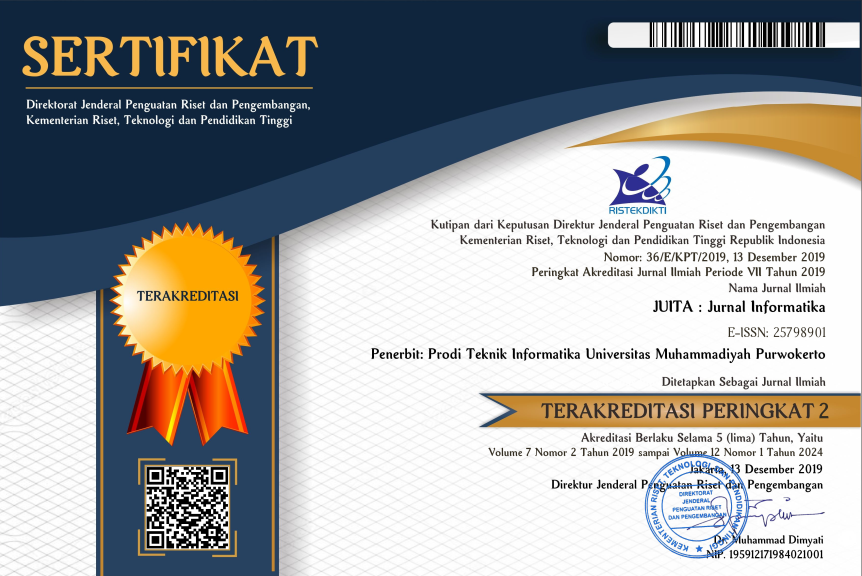Leaderboard Application as A Ranking Media for Internet Users
DOI:
https://doi.org/10.30595/juita.v11i2.17094Keywords:
Leaderboard, Hotspot, Mikrotik, API.Abstract
The technology of utilizing hotspot networks has developed quite rapidly. In its development, internet technology uses a more flexible Mikrotik hotspot because it provides convenience for administrators and users. The object of this study is the hotspot network of Hayam Wuruk University (UHW) Perbanas. The goal is to develop a leaderboard design as a medium for monitoring internet use through the UHW Perbanas hotspot. Its application is through the integration of mikrotik with the web service API as a ranking of internet users against three categories of activities, namely downloads, uploads and internet usage times on each day and month. Each of these categories has 20 users. The test method uses a black box. Hasil testing states that the system is successfully operating, so that it can be implemented in the context of decision making by the management of UHW Perbanas.References
[1] A. Zakaria, A. Prihantara, and A. A. Hartono, “Integrasi Application Programing Interface, PHP, dan MySQL untuk Otomatisasi Verifikasi dan Aktifasi Pengguna Layanan Hotspot MikroTik,” JUITA J. Inform., vol. 7, no. 2, pp. 63–69, 2019, doi: 10.30595/juita.v7i2.4361.
[2] H. Yutanto, “Penerapan Model Promosi Berbasis Web Captive Portal Hotspot dengan Manajemen Terpusat,” J. Sist. Inf. Bisnis, vol. 8, no. 1, pp. 49–56, 2018, doi: 10.21456/vol8iss1pp49-56.
[3] S. Ali, T. Osman, M. Mannan, and A. Youssef, “On privacy risks of public wifi captive portals,” in Data Privacy Management, Cryptocurrencies and Blockchain Technology: ESORICS 2019 International Workshops, DPM 2019 and CBT 2019, Luxembourg, September 26–27, 2019, Proceedings 14, 2019, pp. 80–98, doi: https://doi.org/10.1007/978-3-030-31500-9_6.
[4] N. P. Cechetti, E. A. Bellei, D. Biduski, J. P. M. Rodriguez, M. K. Roman, and A. C. B. De Marchi, “Developing and implementing a gamification method to improve user engagement: A case study with an m-Health application for hypertension monitoring,” Telemat. Informatics, vol. 41, pp. 126–138, 2019, doi: https://doi.org/10.1016/j.tele.2019.04.007.
[5] M. Ortiz‐Rojas, K. Chiluiza, and M. Valcke, “Gamification through leaderboards: An empirical study in engineering education,” Comput. Appl. Eng. Educ., vol. 27, no. 4, pp. 777–788, 2019, doi: https://doi.org/10.1002/cae.12116.
[6] K. Ethayarajh and D. Jurafsky, “Utility is in the eye of the user: A critique of NLP leaderboards,” arXiv Prepr. arXiv2009.13888, 2020, doi: https://doi.org/10.48550/arXiv.2009.13888.
[7] M. S. Khairy, D. W. Wibowo, and M. D. Syahrizal, “Rancang Bangun Aplikasi E-Learning di LBB Primagama Malang dengan Implementasi Konsep Gamifikasi,” MATICS J. Ilmu Komput. dan Teknol. Inf. (Journal Comput. Sci. Inf. Technol., vol. 13, no. 2, pp. 47–50, 2021, doi: https://doi.org/10.18860/mat.v13i2.12131.
[8] S. Bai, K. F. Hew, M. Sailer, and C. Jia, “From top to bottom: How positions on different types of leaderboard may affect fully online student learning performance, intrinsic motivation, and course engagement,” Comput. Educ., vol. 173, p. 104297, 2021, doi: https://doi.org/10.1016/j.compedu.2021.104297.
[9] S. Nuanmeesri, “Developing gamification to improve mobile learning in web design course during the COVID-19 pandemic,” Int. J. Inf. Educ. Technol., vol. 11, no. 12, pp. 567–573, 2021, doi: https://doi.org/10.18178/ijiet.2021.11.12.1566.
[10] E. T. Sihotang and H. Yutanto, “Tata Kelola Organisasi Mahasiswa Melalui Pengembangan Sistem Informasi,” MATRIK J. Manajemen, Tek. Inform. dan Rekayasa Komput., vol. 21, no. 1, pp. 99–110, 2021, doi: https://doi.org/10.30812/matrik.v21i1.1391.
[11] M. Sholeh, I. Gisfas, and M. A. Fauzi, “Black Box Testing on ukmbantul. com Page with Boundary Value Analysis and Equivalence Partitioning Methods,” in Journal of Physics: Conference Series, 2021, vol. 1823, no. 1, p. 12029, doi: https://doi.org/10.1088/1742-6596/1823/1/012029.
[12] T. S. Jaya, “Pengujian aplikasi dengan metode blackbox testing boundary value analysis (studi kasus: kantor digital Politeknik Negeri Lampung),” J. Inform. J. Pengemb. IT, vol. 3, no. 1, pp. 45–48, 2018, doi: http://dx.doi.org/10.30591/jpit.v3i1.647.
[13] T. Rijanandi, T. D. C. S. Wibowo, I. Y. Pratama, F. D. Adhinata, and A. Utami, “Web-Based Application with SDLC Waterfall Method on Population Administration and Registration Information System (Case Study: Karangklesem Village, Purwokerto),” J. Tek. Inform., vol. 3, no. 1, pp. 99–104, 2022, doi: : https://doi.org/10.20884/1.jutif.2022.3.1.145.
[14] O. J. Okesola, A. A. Adebiyi, A. A. Owoade, O. Adeaga, O. Adeyemi, and I. Odun-Ayo, “Software Requirement in Iterative SDLC Model,” in Intelligent Algorithms in Software Engineering: Proceedings of the 9th Computer Science On-line Conference 2020, Volume 1 9, 2020, pp. 26–34, doi: https://doi.org/10.1007/978-3-030-51965-0_2.
[15] F. Pinciroli, J. L. B. Justo, and R. Forradellas, “Systematic mapping study: On the coverage of aspect-oriented methodologies for the early phases of the software development life cycle,” J. King Saud Univ. Inf. Sci., vol. 34, no. 6, pp. 2883–2896, 2022, doi: https://doi.org/10.1016/j.jksuci.2020.10.029.
[16] B. Blumberg, D. Cooper, and P. Schindler, EBOOK: Business Research Methods. McGraw Hill, 2014.
[17] S. Al-Fedaghi, “Conceptual data modeling: Entity-relationship models as thinging machines,” arXiv Prepr. arXiv2109.14717, 2021, doi: https://doi.org/10.48550/arXiv.2109.14717.
[18] A. Laun, T. A. Mazzuchi, and S. Sarkani, “Conceptual data model for system resilience characterization,” Syst. Eng., vol. 25, no. 2, pp. 115–132, 2022, doi: ttps://doi.org/10.1002/sys.21605.
[19] R. Setiawan, R. Parlika, and R. Mumpuni, “Rancang bangun bot auto trade cryptocurrency berbasis web,” J. Inform. dan Sist. Inf., vol. 1, no. 2, pp. 294–301, 2020.
[20] M. S. Khairy et al., “Conceptual data modeling: Entity-relationship models as thinging machines,” arXiv Prepr. arXiv2109.14717, vol. 3, no. 1, pp. 47–50, 2021, doi: https://doi.org/10.48550/arXiv.2109.14717.
[21] A. D. Laksito, “API Gateway Menggunakan SlimPHP pada Aplikasi Kantin Amikom (API Gateway using SlimPHP on Cafetaria Application in Amikom),” J. IPTEKKOM (Jurnal Ilmu Pengetah. Teknol. Informasi), vol. 21, no. 1, pp. 31–42, 2019, doi: https://doi.org/10.33164/iptekkom.21.1.2019.31-42.
[22] G. S. Mahendra and I. K. A. Asmarajaya, “Evaluation Using Black Box Testing and System Usability Scale in the Kidung Sekar Madya Application,” Sink. J. dan Penelit. Tek. Inform., vol. 7, no. 4, pp. 2292–2302, 2022, doi: https://doi.org/10.33395/sinkron.v7i4.11755.
Downloads
Published
How to Cite
Issue
Section
License

JUITA: Jurnal Informatika is licensed under a Creative Commons Attribution 4.0 International License.
















